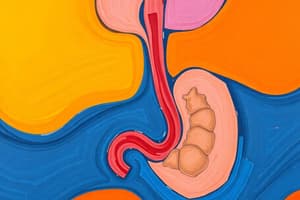Podcast
Questions and Answers
What is a critical nursing intervention to enhance patient recovery after cervical surgery?
What is a critical nursing intervention to enhance patient recovery after cervical surgery?
- Immediate discharge from the hospital
- Preventing infection and monitoring complications (correct)
- Administering sedatives regularly
- Restricting all physical activity
Which of the following is NOT a goal for patients recovering from non-cancerous esophageal disorders?
Which of the following is NOT a goal for patients recovering from non-cancerous esophageal disorders?
- Avoiding respiratory compromise from aspiration
- Attainment of adequate nutritional intake
- Complete bed rest during recovery (correct)
- Minimizing the visibility of neck depression
What type of nutrition management may be needed for patients post-surgery?
What type of nutrition management may be needed for patients post-surgery?
- Nutritional supplementation through gastrostomy or jejunostomy if necessary (correct)
- Solid diet immediately after surgery
- Reduction of fluid intake to prevent swelling
- Exclusion of all vitamins and minerals from diet
Which sign indicates a potential complication post-surgery that requires immediate attention?
Which sign indicates a potential complication post-surgery that requires immediate attention?
Which intervention best supports a patient’s body image after neck surgery?
Which intervention best supports a patient’s body image after neck surgery?
In assessing a patient post-operatively, which factor is crucial for evaluating their knowledge and ability to learn?
In assessing a patient post-operatively, which factor is crucial for evaluating their knowledge and ability to learn?
Which complication may arise from improper management of a gastrostomy tube?
Which complication may arise from improper management of a gastrostomy tube?
What should be monitored closely for signs of fluid status changes post-surgery?
What should be monitored closely for signs of fluid status changes post-surgery?
Which aspect of postoperative education focuses on helping patients manage their conditions at home?
Which aspect of postoperative education focuses on helping patients manage their conditions at home?
What is a significant psychological concern for patients recovering from surgeries involving the neck?
What is a significant psychological concern for patients recovering from surgeries involving the neck?
What is the most common symptom associated with disorders of the esophagus?
What is the most common symptom associated with disorders of the esophagus?
Which of the following is NOT a contributing factor to excessive reflux?
Which of the following is NOT a contributing factor to excessive reflux?
What is one of the main advantages of enteral nutrition?
What is one of the main advantages of enteral nutrition?
Which medication is commonly used for patients with GERD?
Which medication is commonly used for patients with GERD?
What treatment method is commonly recommended based on the stage of esophageal cancer?
What treatment method is commonly recommended based on the stage of esophageal cancer?
What should be avoided to reduce the risk of complications when administering tube feedings?
What should be avoided to reduce the risk of complications when administering tube feedings?
Which dietary component should be avoided to manage symptoms of esophageal disorders?
Which dietary component should be avoided to manage symptoms of esophageal disorders?
What is one method for confirming the placement of a feeding tube?
What is one method for confirming the placement of a feeding tube?
What is a potential complication of tube feeding that requires close monitoring?
What is a potential complication of tube feeding that requires close monitoring?
Which nursing intervention is essential for managing patients postoperatively to reduce aspiration risk?
Which nursing intervention is essential for managing patients postoperatively to reduce aspiration risk?
What is a potential complication of peptic ulcer disease that requires careful monitoring?
What is a potential complication of peptic ulcer disease that requires careful monitoring?
Which dietary management strategy is most appropriate for a patient with peptic ulcer disease?
Which dietary management strategy is most appropriate for a patient with peptic ulcer disease?
Which symptom is most indicative of a possible diagnosis associated with gastric problems?
Which symptom is most indicative of a possible diagnosis associated with gastric problems?
What characteristic symptom is often experienced by someone with chronic dyspepsia related to peptic ulcers?
What characteristic symptom is often experienced by someone with chronic dyspepsia related to peptic ulcers?
Which of the following conditions may contribute to a poor prognosis in patients with gastric cancer?
Which of the following conditions may contribute to a poor prognosis in patients with gastric cancer?
Which laboratory investigation may be relevant in diagnosing certain gastric conditions?
Which laboratory investigation may be relevant in diagnosing certain gastric conditions?
What is a common risk factor for developing peptic ulcer disease?
What is a common risk factor for developing peptic ulcer disease?
Which of the following changes are most likely to occur in a patient suffering from chronic anemia related to gastric issues?
Which of the following changes are most likely to occur in a patient suffering from chronic anemia related to gastric issues?
Which approach is NOT effective in relieving pain associated with peptic ulcers?
Which approach is NOT effective in relieving pain associated with peptic ulcers?
What condition is characterized by painful spasmodic contraction of the anus?
What condition is characterized by painful spasmodic contraction of the anus?
Which of the following tests is used to evaluate colonic transit?
Which of the following tests is used to evaluate colonic transit?
What is the primary dietary intervention for managing malabsorption caused by an autoimmune response to gluten?
What is the primary dietary intervention for managing malabsorption caused by an autoimmune response to gluten?
Which symptom is most commonly associated with appendicitis?
Which symptom is most commonly associated with appendicitis?
Which term describes the permanent inability of the digestive system to absorb certain nutrients?
Which term describes the permanent inability of the digestive system to absorb certain nutrients?
What would be a major risk factor for developing diverticular disease?
What would be a major risk factor for developing diverticular disease?
What should be prioritized in the management of an individual with suspected appendicitis?
What should be prioritized in the management of an individual with suspected appendicitis?
Which of the following is a common complication of chronic functional gastrointestinal disorders?
Which of the following is a common complication of chronic functional gastrointestinal disorders?
What characterizes the defecation pattern in chronic constipation?
What characterizes the defecation pattern in chronic constipation?
Which of the following treatments is beneficial for patients with malabsorption syndromes?
Which of the following treatments is beneficial for patients with malabsorption syndromes?
What is a common complication associated with parenteral nutrition?
What is a common complication associated with parenteral nutrition?
Which condition is identified as the third most common site related to colorectal cancer?
Which condition is identified as the third most common site related to colorectal cancer?
What is indicated when a patient is not interested in ingesting food for an extended period?
What is indicated when a patient is not interested in ingesting food for an extended period?
Which medication action enhances satiety in patients with obesity?
Which medication action enhances satiety in patients with obesity?
What is a potential risk factor for developing colorectal cancer?
What is a potential risk factor for developing colorectal cancer?
What is an important nursing management consideration for intestinal obstruction?
What is an important nursing management consideration for intestinal obstruction?
Study Notes
Disorders of the Esophagus
- Dysphagia: Most common symptom & means difficulty swallowing
- Excess Reflux: May occur due to an incompetent lower esophageal sphincter, pyloric stenosis, and hiatal hernia
- Other Risk Factors: Tobacco use, coffee, alcohol, gastric infection with H. pylori
- Avoid: Caffeine, tobacco, milk, peppermint, alcohol, carbonated drinks, eating hours before bed
- Treatment: Elevate HOB 30 degrees, commonly used GERD meds
- Esophageal Cancer: Two types - Adenocarcinoma and Squamous Cell Carcinoma
- Risk Factors: Alcohol and tobacco use
- Symptoms: Dysphagia, sensation of a mass in the throat, regurgitation
- Treatment: Dependent on the stage of cancer, includes surgery, radiation, chemo, and palliative care
Delivering Nutrition Enterally
- Purpose: To meet nutritional needs when oral intake is inadequate but GI function is intact
- Advantages: Safe, cost-effective, keeps the normal sequence of intestinal and hepatic metabolism, maintains fat metabolism and lipoprotein synthesis, maintains normal insulin and glucagon ratios
- Administration: Tube feeding depends on location
- Pre-Procedure: Patient education and preparation
- Post-Procedure: Tube insertion and confirmation of placement, clearing tube obstructions
- Monitoring: Patient's ability to tolerate the formula amount, clinical response, signs of dehydration, signs of infection
- Assessment: Monitor glucose levels, sudden weight gain, periorbital edema, gastric residual volume
Enteral Nutrition Management
- Oral/Nasal Care: Monitor, prevent and manage complications
- Feeding Equipment: Maintain nutrition balance
- Feeding Administration:
- Administer prescribed rate and method
- Administer water before and after each med & feed, every 4-6 hours, and whenever tube feeding is discontinued or interrupted
- Do not mix meds with feeds
- Maintain delivery system as required
- Do not hang for 4-8 hours off feeding in an open system to avoid bacterial growth
- Nurse Management: Maintain normal bowel elimination, maintain adequate hydration, promote coping by providing support, encouragement, self-care activities, patient education
Nursing Interventions for Post-Surgery
- Patient Education: Extent and nature of the surgery, recovery, post-op self-care, home management, reporting any issues, wound care, drains, diet, medications, speech therapy, support resources, follow-up care
- Assessment: Patient's knowledge, ability to learn, self-care ability, support system, skin condition, nutrition and fluid status
- Complications: Cellulitis, leakage, bleeding, premature dislodgement of tube, tube obstruction
- Nursing Interventions: Meet nutritional needs prevent infection, enhance body image, monitor complications
Non-Cancerous Esophageal Disorders
- Assessment: Non-emergency health history, nutritional status, pain, comorbidities, shoulder drop, dysfunctions, poor cosmesis, visible neck depression
- Goals: Attainment of an adequate nutritional intake, avoidance of respiratory compromise from aspiration, pain relief
- Nursing Interventions: Encourage adequate nutrition, monitor aspiration risk, provide pain relief, provide patient education
- Other Symptoms: Stomach pain, dyspepsia, anorexia, hiccups, nausea, melena, hematemesis, hematochezia, chronic pyrosis, fatigue, sour taste in the mouth, halitosis, early satiety, pernicious anemia, etc.
- Diagnosis: Endoscopy & biopsy
- Treatment: Supportive therapy, fluids, NG meds, chronic management, dietary restriction, stress management, alcohol and NSAID avoidance
Peptic Ulcer Disease
- Pathology: Erosion of the mucous membrane forms an evacuation in the stomach, pylorus, duodenum, or esophagus
- Symptoms: Pain or burning in the mid-epigastrium, heartburn, vomiting, abdominal assessment
- Nursing Management: Maintain nutrition, monitor for and prevent complications like hemorrhage, perforation, penetration and gastric outlet obstruction
Small Intestinal Tumor
- Prevalence: Malignant tumors are most common in older adults, especially men
- Symptoms: Asymptomatic pain, occult bleeding, weight loss, intestinal obstruction
- Assessment: Blood tests for bilirubin, carcinoembryonic antigen (CEA)
- Imaging: Radiograph or abdominal CT
Constipation
- Key Facts:
- Common symptom, subjective to the pt.
- Often ignored
- Straining at stool
- Elimination of small volume, hard dry stools
- May be a consequence of chronic laxative use
- Weakness is a contributing factor
- Diagnosis: Barium enema, sigmoidoscopy, stool test, defecography, colonic transit studies, MRI, FIT
- Complications: Impaction, rectal prolapse, megacolon
- Treatment:
- Identify individual normal patterns
- Increase fiber and fluid intake
- Respond to the urge to defecate
Bowel Incontinence
- Key Facts:
- Characterized by accidental bowel movements
- Often occurs due to issues like nocturnal weakness, weak pelvic floor mm, inflammation, CNS disorders, diarrhea, behavioral disorders
- Can vary from occasional urgency to complete incontinence
- Patient Education: Focus on bowel training, skin care, emotional support
Irritable Bowel Syndrome
- Key Facts:
- Chronic functional disorder
- Characterized by recurrent abdominal pain
- May include disordered bowel movements, including diarrhea, constipation, altered stool consistency, abdominal cramps and borborygmi
Malabsorption & Celiac Disease
- Malabsorption: Inability of the digestive system to absorb one or more macro-nutrients, vitamins, minerals, or nutrients
- Causes: Mucosal disorders, infection, luminal disorders, post-operative conditions
- Treatment:
- Fat-soluble vitamin replacement
- Dietary modification
- Probiotics
- Risk: Osteoporosis
- Celiac Disease:
- Autoimmune response to gluten
- Linked to other autoimmune diseases like type 1 DM and Down Syndrome
- Manifestations: Diarrhea, steatorrhea, pain, distention, flatulence
Appendicitis
- Key Facts:
- Inflamed edematous appendix
- Most common emergency surgery
- Goals: Pain relief, prevent fluid volume deficit, manage anxiety, maintain skin and surgical site integrity
- Symptoms: Rebound tenderness, fever, leukocytosis
Diverticular Disease
- Key Facts:
- Sac-like herniation of the lining of the bowel that extends through a defect in the muscular layer
- Can occur anywhere in the intestine, sigmoid is the most common
- Diverticulosis: multiple diverticula w/ no inflammation
- Diverticulitis: inflammation of the diverticula
- Diagnosis: Colonoscopy
- Management:
- High-fiber diet (cooked vegetables, kiwi)
- Exercise
- Bulk laxatives, stool softeners
- Complications:
- Diverticular obstruction
- Presence of blockage that prevents the normal flow of intestinal contents
- Can be intraluminal or mural obstruction from pressure on the intestinal wall
Inflammatory Bowel Disease
- Key Facts:
- Includes Crohn's disease and Ulcerative colitis
- Chronic inflammatory bowel disease
Indications For Parenteral Nutrition
- Purpose: To provide nutritional support when oral intake is insufficient or inadequate
- Reasons:
- Not interested or unwilling to ingest
- 7-day period of insufficient intake
- Pre-op and post-op nutritional needs
- Prolonged nutritional needs
- Assessment:
- Weight loss 10% or more
- Muscle wasting, poor tissue healing
- Monitoring: Caloric intake, electrolytes
- Complications:
- Pneumothorax
- Clotted or displaced catheter
- Sepsis
- Hyperglycemia
- Rebound hypoglycemia
- Fluid overload
Colorectal Cancer
- Facts:
- 3rd most common site
- Risk factors include: smoking, IBS, IBD, high-fat diet
- Importance of screening procedures
- Types:
- Adenocarcinoma
- Angrectal
Anorectal Disorders
- Types: Anorectal abscess, anal fistula, anal fissure, hemorrhoids, pilonidal sinus or cyst
- Assessment: Includes health history and occupation
- Causes: Complex and multifactorial, including behavioral, environmental, and physiological factors
Obesity
- Complications:
- Linked to increased risk of cancer and a 6-20 year decrease in life expectancy
- Doubles risk of Alzheimer's
- Assessment: Body mass index (BMI), height, weight, waist circumference
- Management:
- Medications: Anti-obesity meds, actions include inhibiting GI absorption of fats, altering brain receptors to enhance satiety or minimize cravings
- Non-surgical: Vagal blocking (implant device to block vagus nerve), gastric balloon
Studying That Suits You
Use AI to generate personalized quizzes and flashcards to suit your learning preferences.
Related Documents
Description
This quiz covers critical information about disorders of the esophagus, including dysphagia and reflux, as well as risk factors and treatments for esophageal cancer. Additionally, it addresses the importance of enteral nutrition when oral intake is insufficient, highlighting its safety and cost-effectiveness. Test your knowledge on these essential topics related to gastrointestinal health.




